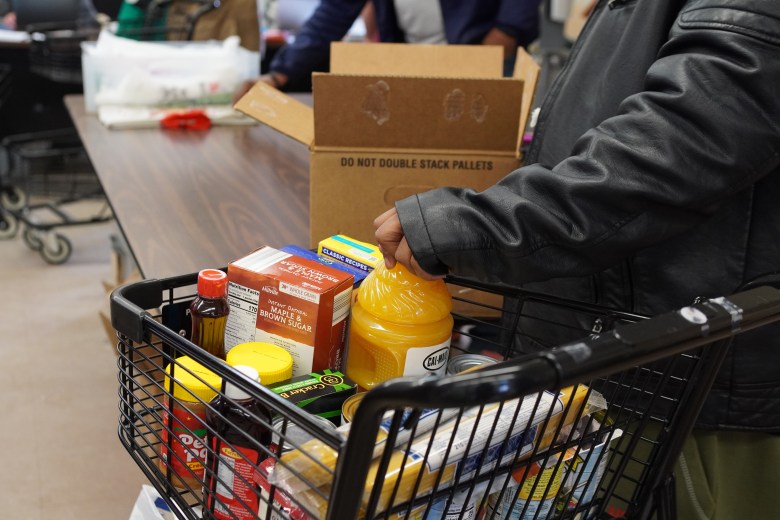The Philly region’s largest hunger relief organization will be facing major challenges following recent U.S. Department of Agriculture funding cuts.
The Share Food Program provides help to many people in the Philadelphia area, executive director George Matysik said.
“We are a food bank serving the five-county area, so Philadelphia and the four collar counties, and our organization serves hundreds of thousands of individuals per week,” Matysik said. “This includes about 300,000 kids per day that we work with through the National School Lunch Program. So we have a network of about 400 total organizations, plus about 800 schools that get food from us. We also have the largest senior hunger relief program in the state.”

Direct impacts
The USDA’s recent cuts will affect several of the Share Food Program’s offerings.
The Local Food Purchasing Assistance Program provides funds to local farmers to produce fresh produce for local food banks. In Pennsylvania, LFPA funding is split between organizations serving every county in the state. Pennsylvania suffered a total of $13 million in cuts to the program, which would have been distributed over the course of three years.
That will translate into about $1.5 million taken from the Share Food Program, which Matysik said will impact local farmers as well as consumers. It’s all part of national USDA actions that were announced and reported in March.
“This was funding that was specifically used to be able to go out and purchase food from Pennsylvania farmers to basically fill in some of the gaps of food that we’re not getting as much, either donated or from the USDA,” he said. “For instance, a lot of the purchases that we’ve done in the last year from Pennsylvania farmers have included Pennsylvania-produced eggs and dairy products, like milk, lean proteins, items like that. Those are some of the primary items that we’re able to buy from Pennsylvania farmers.”
In addition to these cuts, Matysik said there will also be over $6 million in cuts for food that would have been delivered to the organization from the USDA through The Emergency Food Assistance Program, or TEFAP. As with LFPA, the moves will impact farmers, the low-income families that receive food assistance at no cost, and companies that manufacture products that food banks use.
“All of this is being cut from both organizations like ours and the folks that we serve, as well as from farmers and producers who are growing this product,” he said.
“We also saw about $6.5 million in USDA food that was destined for us that was canceled,” he said. “It’s canceled for a variety of reasons by the USDA, but some of it has to do with the trade war that’s developing. The tariffs that are kind of in the process of going into place, as well as just some cuts that are happening for whatever reason from the federal government right now.”
Between food and funds, the organization will be losing out on about $8 million, Matysik said. This comes at a time where there is an increased need for food assistance programs.
“All in all, it means about a 20% reduction in total food coming into the warehouse, as we forecast for the year ahead,” he said. “So, pretty significant challenges at a time, as I mentioned earlier, when we’re seeing our need increase by about 120% — and, in addition to that, the cost of food continues to skyrocket.”

He emphasized this would be a major hit to the agricultural industry.
“The economic impacts that cut USDA programs like TEFAP and LFPA go far beyond just feeding folks that are hungry, which should be enough,” he said. “But in addition to that, it’s also having a huge economic impact on the agriculture industry, which is one of Pennsylvania’s leading industries.”
Changing course
To compensate for these cuts, Matysik said the organization is assessing its options.
“We’re having to sort of diversify our food portfolio,” he said. “That’s already taking place. And we’re also having to go out and seek more donated products coming in. We’ve been sending our trucks further and further out, for five-hour drives to pick up large-scale donations from organizations elsewhere in the state, in the region, that we can bring back here to be able to distribute out in Philadelphia.”
He explained these longer trips increase expenses – demanding more fuel and longer shifts for drivers.

Another concern is the impact of tariffs on costs and sourcing of fruits and vegetables going forward.
“A lot of the food that comes into food banks in this region of the country comes from the ports of Philadelphia and Wilmington,” he said.
He said these federal actions could create real problems, including the unavailability of certain fruits and veggies.
“One of the important things to remember is, you know, for a lot of those imported goods, that you literally can’t grow those products in the United States,” he said.
Jess Bautista is the chief communications officer at Share Food Program. She said potential cuts to SNAP (Supplemental Nutrition Assistance Program) in the midst of these other funding cuts could be “catastrophic.”
“A lot of the federal cuts we’re seeing and the loss of food that we’re experiencing right now is happening at a time when they have some proposed cuts to SNAP, which is truly one of, if not THE backbone of the food security programs we have in this country,” she said. “And I think that cannot be overstated enough.”
For those interested in helping the organization, Matysik said, the Share Food Program website has many resources.
“Folks can also find out how to donate their time and volunteering, how to donate food and making food donations to our organization, and then, very importantly, at this time, is making financial contributions to our organization to be able to keep our work going,” he said.
If you are in need of food assistance, you can also use the Share Food Program’s website to find food near you.
发表回复